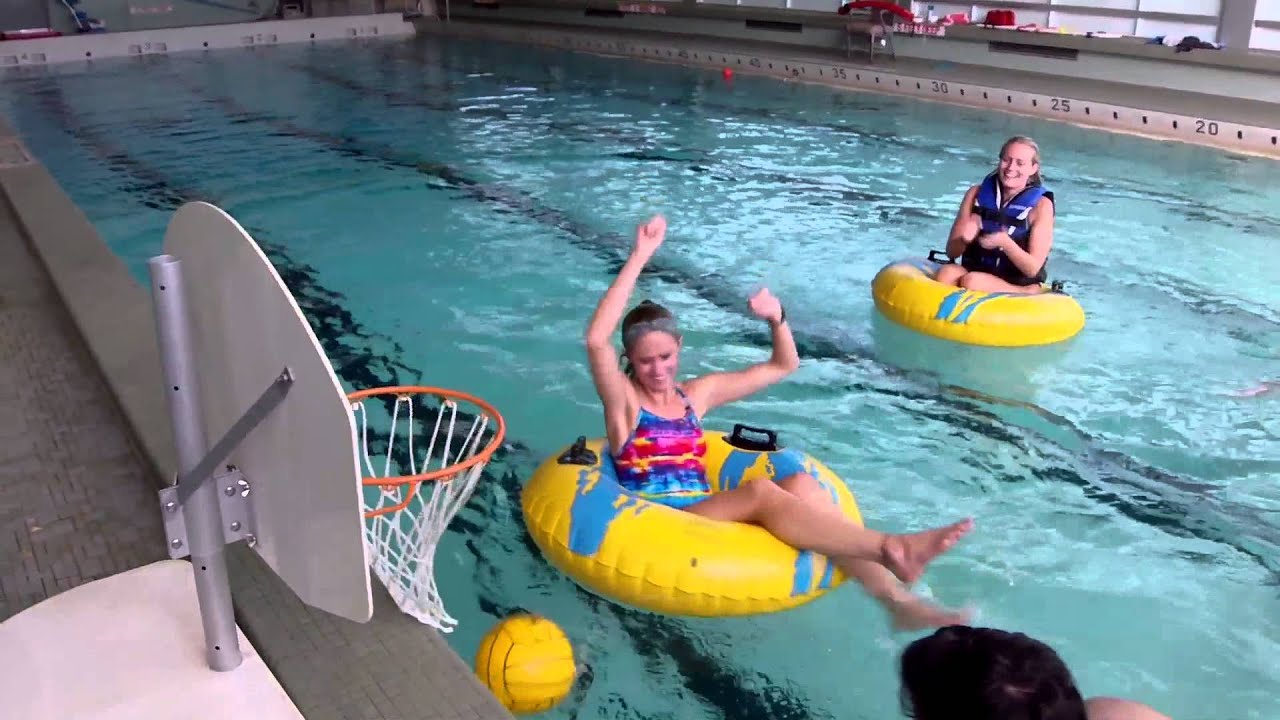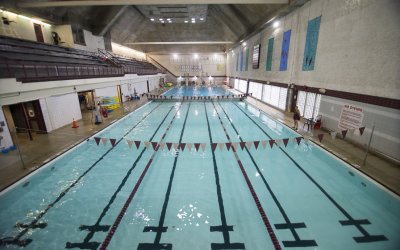Programs & Services: Intramural Sports
Intramural Innertube Basketball
Sport leagues and tournaments for the entire McMaster community, beginner to advanced, individual or team: We want to play with you! Offered fall/winter only.
 Need an accommodation? Submit Accommodation Request
Need an accommodation? Submit Accommodation Request
For more information: intramurals@mcmaster.ca

Activities include: Innertube Basketball, Aquatics
Fall & Winter Leagues
- When are leagues and tournaments in this sport offered? What PlayStyles are available?
Check the Sport Calendar on the 'SPORTS' tab of our Intramural Sports page.
- Who can play Intramural Sports at McMaster? How do I register?
Check the 'REGISTER' tab of our Intramural Sports page.
- Accessible
- Registration Required
Facilities
Innertube Basketball Rules
A) PLAYERS
- OPEN - No gender ratio requirements for the number of players in pool during gameplay. Maximum 3 players; Minimum 2 players.
- Players may wear swimsuits and/or shorts and shirts. No cut-offs, sweatpants or any type of clothing that may unravel. Players may not wear jewelry.
B) GAME SETUP:
- Playing Area: Width of the pool with water polo basketball nets at each side.
- Game Length: Two 18-minute halves will be played with a 4-minute half-time in between. (Game staff may shorten games to accommodate pool schedule.)
- The clock will run continuously throughout the game. Exception: Time out.
- One (1) time-out per team per game. A time-out is one (1) minute long and the clock stops. A team must be in possession of the ball to call a time-out.
- OVERTIME
- When the score is tied at the end of regulation playing time, an overtime period will be played. The winner shall be the team that is first ahead by 4 points or ahead at the end of 3 minutes.
- If teams do not have the minimum number of players required 10 minutes after the start of the game they will FORFEIT the game.
C) GAME PLAY:
- All players must sit in the tube with both legs hanging over the tube.
- To begin play, the teams line up, with all players touching their 'end-wall' (at the opposite ends of the pool). The referee will blow their whistle signaling players to swim toward the centre of the pool, where they will have thrown the ball for a swimming face-off.
- Out of Bounds: If the ball goes out of bounds onto the pool deck (behind the net, or along the sides), the team to last touch the ball will be penalized by awarding a throw in to the opposing team.
- On throw-ins, the defense must be at least 3 feet away until the thrower passes or moves with the ball. The thrower has 5 seconds to pass or begin moving the ball.
- After each point, the ball must be touched by a player touching the baseline (edge of the pool).
- Substitution: Players can request a substitution from an official after a basket is made, when a throw-in is about to occur, at time-out, when a penalty has been called or between halves. the new player must wait on the pool deck until their sub is completely out of the water; failure to comply will result in possession being awarded to the other team. Subs not in play must be out of the pool on the pool deck. The official will let you know if you can substitute. There is no limit to the amount of substitutes.
- Contesting a player who has possession of the ball is legal but must be done from tube to tube. (You can only make contact with the ball, NOT THE PERSON.) Unnecessary roughness will not be tolerated and will be a personal foul and if flagrant enough, suspension from the game and possibly from Intramurals.
- A jump ball is called if opposing players have equal possession of the ball, or when opposing players simultaneously knock the ball out of bounds. (Jump ball goes to the team last on defense.)
- No player may hold onto the side of the pool or goal/net when catching, receiving or passing the ball. A penalty may be assessed resulting in a possession given to the opposing team.
- No player may touch the ball while not sitting in their innertube - subject to referee's discretion (i.e., if a player is falling out of the tube and making a pass play may be allowed to continue).
- Blind Throws: Throws made while a player cannot see their target (e.g., backhanded or over their head while their back is to their target) are penalties and will be assessed as a Major Foul (see below).
D) SCORING:
- A field goal (made basket) counts 2 points.
- A shot can be made with two hands.
- In order for a team to take a shot, all three of their players must be past the half court line. If they aren’t, and a shot is taken, the basket does not count and it is a turnover. This is to ensure that no “cherry-picking” occurs from either team. However, a team may shoot a shot behind the half court line at any time. If this shot is rebounded by the team on offense, they must wait until all team members cross half court before shooting a two-pointer.
- An offensive player may not be in the lane area when a goal is attempted. The lane area is marked by cones and first black line that runs through the pool. If a shot is attempted, an offensive player may go into the lane to get the rebound... but must get out of the lane before they attempt a shot. Offensive players may cross through the lane, as long as a shot is not attempted. There is no such thing as 3 seconds in the lane.
D) SUMMARY OF FOULS
1. Violations: Penalty - Other team gets ball at nearest spot of infraction.
- a) A player makes contact with another player's tube using their hands/arms or legs/feet - tube on tube contact only!
- b) A player deliberately touches the pool wall while in possession of the ball.
- c) Holding the ball underwater.
- d) Cradling the ball in the lap. The ball must be kept up, with arms extended to a height above the head.
- e) A player playing the ball while out of the tube.
- f) A player holding the ball longer than 5 seconds, unless they are moving with it.
- g) A player interferes with a throw in.
2. Personal Fouls: Penalty - Other team gets the ball nearest the spot of the foul. During the last minute of the second half the clock will stop for all goals, fouls, and violations. After 3 personal fouls on a player, he/she will have fouled out of the game. (This is not an ejection...”fouling out”…just like in basketball.)
- a) Holding, pushing, hitting or jumping on the tube, or dumping an opponent not holding or in control of the ball is a foul. Control is defined as holding the ball, touching the ball, pushing water around the ball to move it.
- b) Making bodily contact with an opponent is a foul (hitting, striking, grabbing, holding, etc.).
- c) Intentionally splashing water in the opponents' face is a foul.
- d) Player persistently repeating a violation, even after the referee has given warnings, may be ejected from the game.
- e) Exhibiting unsportsmanlike conduct (i.e., swearing, taunting)
3. FLAGRANT FOULS: Offending player shall be removed from play for the remainder of the game.
Examples:
- a) A player attacks, strikes, or kicks an opponent in such a manner as, in the opinion of the referee, to endanger the person in anyway.
- b) A player deliberately throws the ball at an opponent with the intent to injure.
- c) A player blatantly refuses to obey the officials' requests.
- d) A player exhibits unsporting behaviour.
- e) Holding a player underwater.
- f) Any conduct that the official feels is VERY unsportsmanlike conduct. ( i.e., abusive language toward opponent or officials)
- g) Dunking the ball and/or hanging on the rim. Our equipment is fragile....we can’t risk having it broken, as these are the only goals we have.
